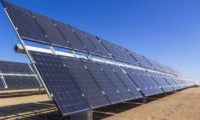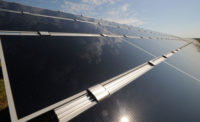The U.S. solar-energy industry is holding its breath following the unanimous ruling by the International Trade Commission (ITC) that U.S. solar-panel producers have been damaged by imports of crystalline silicon photovoltaic (CSPV) cells. If President Donald Trump affirms the decision, tariffs could double the cost of imported panels to protect domestic producers. Solar-energy developers and contractors fear the tariffs will cripple the solar-PV energy market sector, which experienced record growth in 2016 thanks to the price of solar energy’s precipitously dropping to $0.37 per watt. Utility-scale solar development, appears to be most at risk if tariffs are imposed.
Utility-scale solar developers and contractors accelerated projects to meet tax credit deadlines in 2016, contributing to the year’s enormous success and resulting in the installation of 14,626 MW. In 2017, projections were modest, but the extension of the tax credit in late 2016 set the stage for a steady year of resource building and workforce development, followed by what were expected to be record-setting years for solar in 2018 and 2019. But in spring 2017, Suniva, a Chinese-owned solar panel manufacturer based in Georgia, filed its Section 201 tariff petition. German-owned SolarWorld later joined as a co-petitioner.
The Trade Commission voted 4–0 in the petitioners’ favor in September. It is now considering the remedy, with a vote on the remedy scheduled for Oct. 31. The petition requests that a tariff of $0.40 be added to each watt on CSPV panels manufactured outside of the country, and the uncertainty already has the industry in a tailspin. McCarthy Building Cos., ranked as the sixth largest EPC in the U.S. by industry trade publication Solar Power World, has had a 100-MW project canceled, and 400 MW more of planned utility-scale solar construction put on hold with little hope of being built due to the tariff threat. Other industry companies report that they are in a similar position. The industry overall now expects to come in below projections this year, and next year to be flat. The commission’s report is due on President Trump’s desk by Nov. 13, and the president is scheduled to make a decision on the tariffs—accept, modify or reject—by Dec. 31.
Construction Jobs at Risk
The solar industry employs more than 260,000, with an estimated 88,000 American jobs in utility-scale solar design, engineering, construction and manufacturing. These jobs are now threatened by the tariff.
Steady growth of the solar workforce in recent years has provided construction-related employment opportunities to outlying and rural communities across the country, where utility-scale solar is commonly constructed. In fact, programs like McCarthy’s Training Within Industries successfully retrained more than 1,000 workers from other industries in solar construction this year alone. And, in 2017 McCarthy’s solar projects will record at least 207,659 work hours, giving a sense of how many individuals and families rely on the solar construction industry. With as much as 50% of the previously expected 2018 projects being cancelled or put on hold, McCarthy’s workforce growth is expected to be flat as a result of the tariff.
Learning from Past Mistakes
The last time a tariff was issued using the same U.S. trade law was in 2002, when President George W. Bush levied a 30% tariff on foreign steel. The action’s ripple effect cost an estimated 200,000 jobs in U.S. steel consumption industries. While the extent of the impact of a solar tariff will not be known for years, it is already negatively affecting the entire industry. McCarthy’s hope is that if a tariff is levied, it will be on the lower-end of the scale, allowing the industry to manage and minimize the impact so that solar can be back on track within a few short years.
Scott Canada is a senior vice president of operations for McCarthy Building Cos.’ Renewable Energy Group and is a member of the board of directors for the Solar Energy Industry Association.





Post a comment to this article
Report Abusive Comment